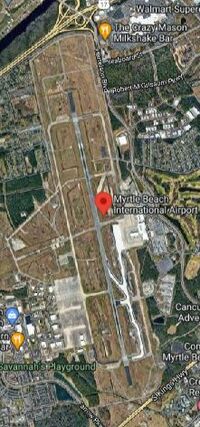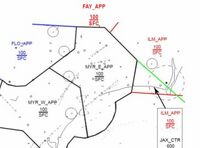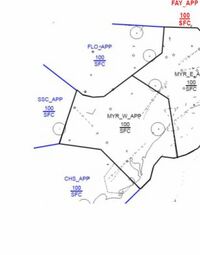Myrtle Beach ATCT/TRACON: Difference between revisions
| Line 319: | Line 319: | ||
|} | |} | ||
</tab> | </tab> | ||
<tab name="VFR Aircraft within TRACON"> | |||
VFR Aircraft entering the Class Charlie airspace will be given a discrete beacon code.<br> | |||
If an aircraft departs from MYR and does not request a flight following, the aircraft will be handed off from LC to TRACON and released to UNICOM once clear of the Class Charlie.<br> | |||
</tabs> | </tabs> | ||
Revision as of 12:15, 2 May 2023
Area Information
| ICAO Code | Airport Name | Airspace | IFR Beacon Codes | VFR Beacon Codes |
|---|---|---|---|---|
| KMYR | Myrtle Beach International Airport | C | 6501-6577 | 6501-6577 |
| Purpose This document prescribes the procedures to be utilized for providing air traffic control services at the Myrtle Beach Air Traffic Control Tower (MYR ATCT) and TRACON. The procedures described herein are supplemental to the Jacksonville ARTCC Facility Operating Guidelines and FAA Order JO 7110.65, as well as any published FAA guidelines or procedures. Distribution |
Operational Positions
| Position | Radio Name | Callsign | Relief Callsign | Symbol | Frequency |
|---|---|---|---|---|---|
| Ground | Myrtle Beach Ground | MYR_GND | MYR_1_GND | 8MG | 120.300 |
| Tower | Myrtle Beach Tower | MYR_TWR | MYR_1_TWR | 8MT | 128.450 |
| Position | Sector Name | Callsign | Relief Callsign | Symbol | Frequency |
|---|---|---|---|---|---|
| EARDR | Radar East | MYR_E_APP | MYR_1E_APP | 8E | 119.200 |
| WARDR | Radar West | MYR_W_APP | MYR_1W_APP | 8W | 127.400 |
Sector in Red is the primary sector.
| Airport | Position | Radio Name | Callsign | Relief Callsign | Frequency |
|---|---|---|---|---|---|
| KCRE- Grand Strand | Ground | Stand Ground | CRE_GND | CRE_1_GND | 121.800 |
| Tower | Stand Tower | CRE_TWR | CRE_1_TWR | 124.600 | |
| KGGE- Georgtown County Airport | No Active Tower or Ground Facilities | ||||
| KHYW- Conway-Horry County Airport | No Active Tower or Ground Facilities | ||||
| 5J9- Twin City Airport | No Active Tower or Ground Facilities | ||||
Clearance Delivery
Initial Altitude for all IFR Departures is 3,000 feet. Pilots shall expect their cruise (if higher) in 10 minutes after departure.
There is no published departure procedures for Myrtle Beach. All aircraft will be cleared to their destination via radar vectors to their first fix.
Phraseology
{Callsign}, You are cleared to the {Arrival Airport} Airport via radar vectors {First fix} then as filed. Maintain 3,000, expect {cruise} one-zero minutes after departure. Departure Frequency {departure frequency}, squawk {squawk code}.
VFR with or without flight following maintain VFR at or below 3,000 feet.
Myrtle Beach is a class Charlie. All VFR traffic will be issued a discrete squawk code.
Phraseology
{Callsign}, Maintain VFR at or below 3,000 feet, {departure frequency}, squawk {squawk code}.
All VFR remaining in the pattern will require coordination with the tower and will be directed to contact when ready for taxi.
Routings to ZTL, ZMA, ZDC and ZHU ARTCCs have been coordinated through letters of agreements (LOAs).
The table below list the common frequencies used a departures frequencies by MYR Clearance Delivery.This guide is only that, a guide. The actual departure frequency has to determined based on coordination with the other controllers that are online.
| Position | Callsign | Traffic Direction | Symbol | Frequency |
|---|---|---|---|---|
| Radar East | MYR_E_APP | East | 8E | 119.200 |
| Radar West | MYR_W_APP | West | 8W | 127.400 |
Ground
Ground Control does not authorize pushbacks or startups unless the aircraft pushing will enter the controlled area during the pushback.
Phraseology
Aircraft does not enter the controlled area
{Callsign}, Push back and start is at your discretion.
Aircraft does enter the controlled area
{Callsign}, Push and start approved, push tail facing (direction)
As the taxiways at Myrtle Beach are simple, there are no defined routes for taxi.
Phraseology
To Runway
{Callsign}, Runway {Number} taxi via {taxi instructions}.
To Ramp
{Callsign}, Taxi to the ramp via {taxi instructions}.
Ground Control must advise Local Control of all intersection departures verbally or through the chatbox in the controller client.
Phraseology
{Callsign}, Runway {Runway Number} at {Intersecting Taxiway}, taxi via {taxiways}.
Ground controller shall ensure each pilot has the current ATIS information prior to being handed off to Local Control
GC must transfer communications to LC if an aircraft is to operate on an active runway.
Phraseology
{Your Callsign}, {Their Callsign} (wait for response)
One to cross runway {number} at {Taxiway} (wait for response)
If Approved: Approved {Their OI} Response: Approved {Your OI}
If Denied: Hold {reason}
Once Crossing Completed: {Your Callsign}, {Their Callsign} (wait for response)
Crossing Complete {Your OI}, Roger {Their OI}
During high volume sessions, GC should use the following procedures for taxiing aircraft to the commercial ramp:
Inbound:Once aircraft have landed and are on GC frequency, the GC should ask the pilot using the following phraseology, “Say gate”, GC will use the information to observe available/unavailable gates and decide whether to hold inbound aircraft at a safe location or instruct the pilot to taxi to the ramp.
Phraseology
{Callsign}, Say Gate.
Outbound:When the pilot calls for clearance, the controller should read the clearance, verify read-back, and resolve any flow control issues:
To properly plan for taxiing aircraft holding for gates and to mitigate taxiway congestion, GC should instruct the pilot to “Advise prior to push”. This should assist controllers in deciding which aircraft need to hold at gates to avoid pushbacks that may interfere with timed departures and mitigate taxiway congestion.
When the aircraft calls for pushback, the controller should determine whether to approve or deny the request. Pushback requests can be denied by stating “hold your push” or “hold position”.
If a controller approves pushback, the controller should inform the pilot “push at pilot's discretion”
Phraseology
After Readback: {Callsign}, Advise Prior to Push
Deny the push: {Callsign}, Hold your push or {Callsign},Hold Position
GC shall instruct aircraft to contact tower unless otherwise agreed upon by LC. LC can request pilot monitor the frequency instead of contacting.
Phraseology
{Callsign}, Contact Myrtle Beach Tower 128.45
Tower
LC has responsibility for a 2.5 mile radius from the MYR field from surface up to and including 2,000 feet MSL. LC is also authorized to control 3,000 feet MSL and below in the published departure corridors.
Runway 18 Departure Corridor
The airspace from midfield of the runway from a 150° bearing clockwise to a 210° bearing, extending 5 miles from the departure end of the runway, surface to 3000 feet. This airspace is delegated to LC for automatic releases of MYR departures when runway 18 is in use. IFR Aircraft shall remain 3 miles east of a 150° bearing from the midfield of the runway clockwise to 3 miles west of a 210° bearing, 8 miles from the departure end of the runway. VFR aircraft shall remain clear of the departure corridor and 8 miles from the runway from a 150° bearing clockwise to a 210° bearing.
Runway 36 Departure Corridor
The airspace from midfield of the runway from a 330° bearing clockwise to a 030° bearing, extending 5 miles from the departure end of the runway, surface to 3000 feet. This airspace is delegated to LC for automatic releases of MYR departures when runway 36 is in use. IFR Aircraft shall remain 3 miles west of a 330° bearing from the midfield of the runway clockwise to 3 miles east of a 030° bearing, 8 miles from the departure end of the runway. VFR aircraft shall remain clear of the departure corridor and 8 miles from the runway from a 330° bearing clockwise to a 030° bearing.
The active runway shall be determined based on wind and known
factors that may affect the safety of takeoff/landing operations.
Runway 18 is designated as the calm wind runway.
7110.65Z Runway Selection
LC will provide separation for aircraft in the LC airspace.
LC shall provide initial radar separation between successive departures.
When automatic departures are in effect, IFR jet/turbojet departures
shall be released on runway heading climbing to 3,000 feet.
LC has the option to assign all NON-JET aicraft runway heading or a fanned heading that will conform to the applicable departure corridor.
Phraseology
{Callsign}, {Departure Instruction}, Wind {direction} at {speed}, Runway {Runway}, Cleared for takeoff
{Callsign}, Contact Departure {frequency}
LC shall be responsible for separation of all arrival aircraft that have
been handed off by TRACON from all departing aircraft still under LC
jurisdiction
Phraseology
{Callsign}, {Traffic Advisories} , Wind {direction} at {speed}, Runway {Runway}, Cleared for land
Practice Instrument Approaches: Issue special instructions as verbally coordinated with the
TRACON. Practice Instrument Approaches shall assign runway heading and maintain 2,000 feet. Departure frequency as assigned by approach control.
Phraseology
{Callsign}, Fly Runway Heading, Climb and Maintain 2,000, Contact Approach on {Frequency}
LC shall NOT change the approach sequence without coordination. Communication transfer must be completed prior to five nautical miles
from the runway.
LC shall assign IFR aircraft runway heading and 3,000 feet
LC must verbally coordinate with departure prior to frequency change.
Phraseology
AFTER COORDINATION WITH TRACON: {Callsign}, Fly {Heading}, Climb and Maintain {Altitude}, Contact Approach on {Frequency}
LC is authorized automatic releases from the TRACON controller so long as the aircraft departs on the pre-coordinated active departing runway(s) on approved departure headings
In order for automatic releases to be authorized, procedures in this document shall be followed.
Departure releases must be obtained if automatic releases are suspended by TRACON.
Phraseology
Requesting Release: {Their Callsign}{Your Callsign},
(Hold for answer)
Release for departure, {Airport} {Callsign} {Runway} {First Fix}
(Hold for Answer)
If Approved: Approved{Any Restrictions} {Their OI} Roger, Approved {Restrictions} {Your OI}
If Denied: Hold; Expect clearance at {Zulu} {Their OI} Roger {Your OI}
Myrtle Beach ATCT is a visual/VFR tower and shall not initiate or accept any radar handoffs and shall not initiate control/start track on any target.
LC shall manage the ATIS for KMYR
The ATIS shall be on 123.925
TRACON Information
| EARDR (MYR_E_APP) is the primary "combined" radar position for Myrtle Beach Tracon. No other sectors shall be staffed until the "combined" position is in use. EARDR may delegate a portion of its airspace to WARDR.
|
| WARDR (MYR_W_APP) is the secondary radar position for Myrtle Beach Tracon. EARDR may delegate a portion of its airspace to WARDR.
|
<tab name="VFR Aircraft within TRACON">
VFR Aircraft entering the Class Charlie airspace will be given a discrete beacon code.
If an aircraft departs from MYR and does not request a flight following, the aircraft will be handed off from LC to TRACON and released to UNICOM once clear of the Class Charlie.


